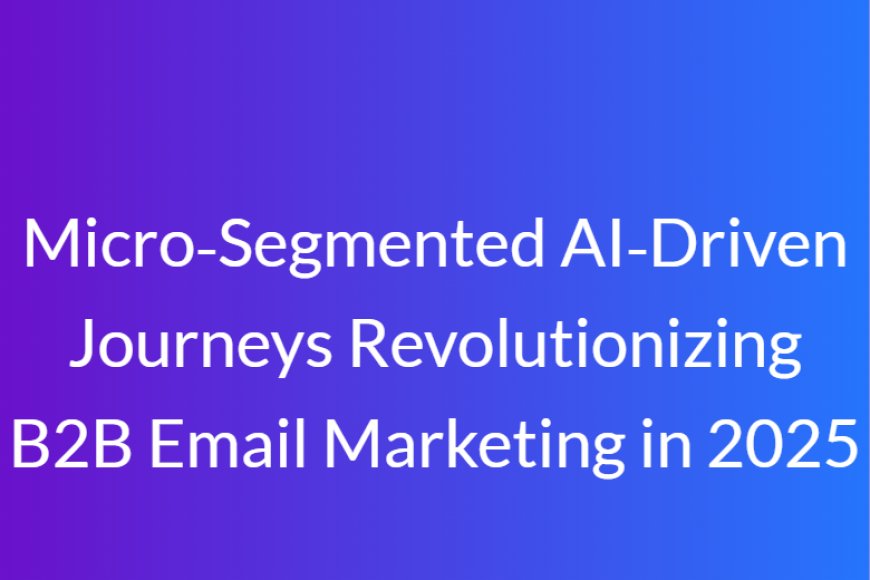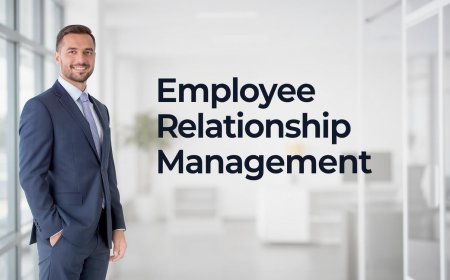Micro‑Segmented AI‑Driven Journeys Revolutionizing B2B Email Marketing in 2025
In 2025, B2B Email Marketing enters a new era defined by hyper-specific targeting and AI-driven customer journeys.

In 2025,B2B Email Marketing
enters a new era defined by hyper-specific targeting and AI-driven customer journeys. Companies no longer rely on broad segments like industry or company size. Instead, they dissect audiences into micro-segments that consider role, behavior, firmographics, and intent signals. Micro?segmentation deeply integrated with AI enables brands to deliver extremely relevant email experiences that scale through automation. This trend is reshaping how B2B Email Marketing nurtures, engages, and converts leads at every stage of the funnel.
Why Micro?Segmentation Matters Now
Traditional segmentation groups buyers into wide buckets marketing, sales, or executive. In 2025, these categories are no longer enough. Todays prospects expect relevancy based on specific business context, past interactions, and unique challenges.B2B Email Marketing must move beyond generic blasts to build credibility and urgency. Micro?segmentation breaks audiences into granular segments like IT decision-makers in retail, or mid-market procurement teams exploring automation. Each segment receives tailored content that reflects their context and journey stage.
Precision at scale is possible only because AI can process large data sets in real time. With the right tech stack, marketers can automate personalized messaging that resonates with individual recipients. This results in higher engagement, lower unsubscribe rates, and faster sales velocity.
Building Smart Segments with Buyer Data
Micro?segmentation begins with rich data collection. Modern B2B Email Marketing relies on integrating CRM, web analytics, intent providers, and firmographic databases. Once aggregated, this data creates profiles based on:
-
Behavioral signals: page visits, demo downloads, content consumption, webinar attendance
-
Firmographics: company size, vertical, revenue tiers
-
Role-specific intent: seniority level, project ownership, budget responsibility
-
Lifecycle stage: new lead vs. lead reactivating after abandonment
AI analyzes these attributes to create dynamic segments. For example, a high-revenue lead with repeated visits to a pricing page might be classified as a high-value intent lead. They receive emails focusing on ROI calculations and executive-level insights. Meanwhile, early-stage leads in small startups might receive onboarding resources or educational content about general problem-solving.
AI-Powered Journey Orchestration
Micro?segmented audiences require dynamic email flowsnot static sequences. AI-driven journey orchestration platforms make this possible by:
-
Detecting segment entry and exit in real time
-
Retrieving content assets aligned with the leads context
-
Scheduling emails at optimized intervals per segment
-
Triggering follow-up actions (web push notifications, sales alerts, ad retargeting)
For instance, a lead who signs up for a whitepaper on compliance transitions into a micro-segment labeled Regulatory-Conscious Leads. AI then triggers a series of emails: a regulatory checklist, an upcoming compliance webinar, and finally, a case study from a similar company that successfully navigated compliance challenges.
This automated orchestration aligns with how B2B Email Marketing is evolvingbecoming less manual and more adaptive.
Personalized Content Blocks at Scale
AI helps B2B Email Marketing go beyond merge tags through modular email design. Emails include dynamic content blockseach tailored to a micro?segment:
-
Role-based CTA (e.g., See ROI Calculator for CFOs vs. View Technical Integration Guide for CTOs)
-
Use-case snippets aligned with industry
-
Inline testimonials from companies matching the recipients firmographics
-
Variable send-times based on historical open behavior
These elements create highly personalized emails that feel customized. AI tests variations automaticallyrotating one version of a block against another to learn which drives higher conversion within that segment.
Linking Email Engagement to Sales Activity
A powerful aspect of micro?segmentation is its integration with sales systems. AI tags email behavior and forklifts it directly into CRMtriggering specific sales actions.
For example:
-
Interaction with a product demo link might trigger a Request follow-up call task in Salesforce
-
Clicking on pricing details might route leads to a senior rep
-
Unusual engagement (e.g., multiple visits in a week) might trigger direct chat outreach or ad retargeting
This seamless flow ensures B2B Email Marketing is followed immediately with relevant outreach rather than being treated as standalone communication.
Testing Micro?Segment Relevance with AI Insights
AI doesnt just automateit evaluates performance. For micro?segments, AI monitors:
-
Segment-specific open, click, and reply rates
-
Funnel progression rates vs. control groups
-
ROI impacte.g., which segments convert faster or buy larger
-
Predictive scoresidentifying which segment attributes drive best outcomes
Marketers use this insight to fine-tune segment definitions, update journey flows, and refine messaging to match buyer preferences precisely.
Use Case: IT Leader vs. Business Leader Segments
Consider a SaaS company using micro?segmentation:
-
IT Leader Segment: Visits to tech documentation and API pages trigger a content series featuring integration tips, a technical webinar, and a sandbox invite. The AI journey includes a technical deep-dive demo invitation at the right time.
-
Business Leader Segment: Engages with ROI calculators and business-case content. They receive emails showcasing TCO comparisons, peer testimonials, and financial models. High interest flags sales outreach from a senior executive rep.
This dual-path approach ensures both personas receive uniquely relevant messagingeven if theyre in the same account. That precision accelerates progression, reduces friction, and increases conversion potential.
Scaling Personalization Without Adding Overhead
Concerns about micro?segmentation often center on complexity. However, AI reduces workload significantly:
-
Segments are defined based on algorithmic patterns
-
Content modules are tagged with metadata to match segment descriptors
-
Journeys are assembled dynamicallyno manual mapping
-
AI continuously learns and improves engagement triggers
Marketers simply need to produce modular assets and segment definitionsAI handles distribution, orchestration, and optimization.
Ensuring Compliance and Trust in Data Use
With deeper data usage comes responsibility. B2B Email Marketing must maintain compliance with GDPR, CCPA, and emerging regulations:
-
Maintain transparent data collection and usage policies
-
Offer preference centers for granular communication control
-
Implement data retention practices aligned with regulations
-
Provide opt-out at micro?segment levelallowing recipients to exit specific journeys without losing all communication
Trust ensures recipients stay engaged even when emails become highly relevant and data-backed.
Challenges of Micro?Segmentation
While powerful, micro?segmentation presents challenges:
-
Data quality: Requires clean, consistent, and first-party validated data
-
Platform compatibility: AI orchestration requires robust integration with CRM and content libraries
-
Content modularization: Marketers need to build assets that can be mixed and matched dynamically
-
Performance tracking: Attribution across micro-journeys demands precise analytics setup
However, the performance gainshigher open rates, faster funnel velocity, more revenue per leadjustify the investment.
Measuring Micro?Segmentation Success
Key metrics to monitor:
-
Engagement lift vs. non-micro-segmented control
-
Conversion rate improvement per micro-journey
-
Reduction in lead-to-opportunity time
-
ROI per segmentrevenue influenced vs. cost to operate
-
Subscriber retention per segment (unsubscribe/drop-off rates)
Rich reporting capabilities help optimize further micro-segments, assets, and workflows.
Adopting Micro?Segmentation in Your Strategy
To start:
-
Audit existing segmentation practicesidentify key roles, behaviors, and intent signals
-
Collect required datafirmographics, behavioral, intent, first-party forms
-
Define 35 initial micro?segmentse.g., IT engaged, financial stakeholder, expansion-ready lead
-
Build modular assetscontent blocks, dynamic CTAs, persona-specific visuals
-
Choose an AI-driven platform that supports real-time journey orchestration
-
Test with small cohorts, compare results against traditional segments
-
Scale based on insights, refining micro?segments and content over time
Leading in B2B Email Marketing now depends on precise relevance, delivered at scale through AI. Micro?segmentation provides both the depth of targeting and the automation to operate efficiently. This trend defines the future of personalized, intelligent email engagement.
Read the Full Blog Now @ https://acceligize.com/featured-blogs/b2b-email-marketing-trends-to-watch-in-2025/
About Us
Acceligize is a global leader in B2B demand generation and sales enablement, specializing in connecting businesses with highly targeted, ready-to-engage prospects. Through innovative digital marketing strategies, buyer intent data, and multi-touch campaigns, Acceligize empowers sales and marketing teams to drive growth, generate qualified leads, and achieve faster revenue outcomes. With a focus on accuracy, engagement, and scalability, Acceligize delivers real, measurable results to enterprises across industries.






























